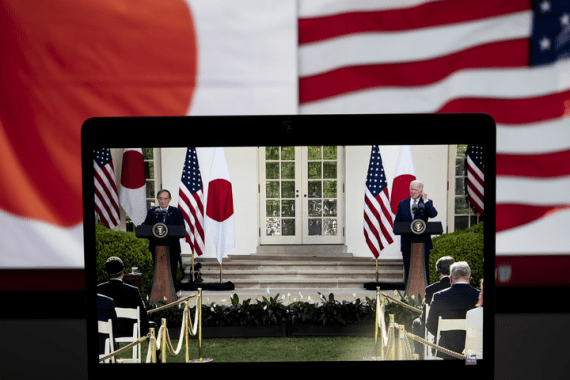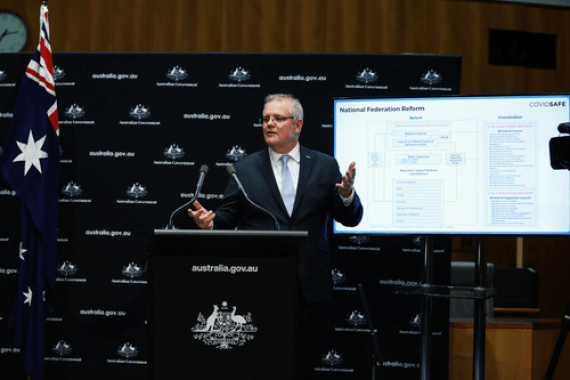[Guide]
· The United States, Japan, India and Australia seek a favorable balance of power through the “four-nation mechanism” in an attempt to occupy an advantageous position in the game with China.
·The “four-nation mechanism” has some inherent obstacles and shortcomings, which are difficult to overcome in the short term.
(It takes about 5 minutes to read this article)
On September 24, the “four-nation mechanism” of the United States, Japan, India and Australia held its first offline summit in Washington. The leaders of the four countries discussed the new crown epidemic, maritime security, cyber security and other issues. According to a joint statement issued after the meeting, the four countries reaffirmed the establishment of a partnership to jointly build a “free, open, and inclusive” Indo-Pacific region.
The White House was photographed in Washington, USA on September 3.Photo by Xinhua News Agency reporter Liu Jie
Prior to this summit, the United States, Britain and Australia just announced the establishment of the trilateral security cooperation mechanism AUKUS. Australia’s nuclear submarine program and the possible start of the United States outside the “four-nation mechanism” have aroused widespread concern in the international community. Although Japan is happy to see the results of AUKUS, India’s mentality is more complicated, and this summit also has the consideration of rebuilding trust.
In recent years, as the strategic focus has gradually shifted to the Indo-Pacific region,The U.S. attempts to use the “four-nation mechanism” as its basis to advance its “Indo-Pacific strategy” and start a geopolitical battle with China. The “Indo-Pacific strategy” and the “four-nation mechanism” represent the outdated Cold War mentality. In today’s world, there is no way out for group confrontations and geopolitical games.
Abacus of Shikoku
The embryonic form of the “four-nation mechanism” appeared in 2007. The four countries of the United States, Japan, India and Australia conducted exploratory discussions on the mechanism, but they were unable to advance because of strong opposition. The Trump administration of the United States proposed the “Indo-Pacific Strategy” in November 2017. In the same month, diplomats from the four countries of the United States, Japan, India and Australia met for the first time during their participation in the ASEAN series of meetings, marking the “resurrection” of the “four-nation mechanism”. The four countries expressed their intention to develop the “four-nation mechanism” into a substantial cooperation platform.
After the Biden administration took office, it did not comment on Trump’s “Indo-Pacific strategy”, but was still committed to the promotion of the “four-nation mechanism” and set up the post of “Indo-Pacific affairs coordinator.” On March 12, US President Biden, Japanese Prime Minister Yoshihide Suga, Indian Prime Minister Modi, and Australian Prime Minister Morrison held an online meeting of leaders of the “four-nation mechanism” to discuss the North Korean nuclear issue, the situation in Myanmar, and maritime security issues. , Can be regarded as the prelude or prelude to this offline meeting.
so far,The “four-nation mechanism” is still only a diplomatic forum. The main purpose of the mechanism is to allow the four countries to share and exchange concerns about regional issues, and to discuss the possibilities and ways of cooperation with each other or with other countries. The “four-nation mechanism” has a relatively broad agenda, involving all aspects of politics, economy, and security. Strictly speaking, it is not a treaty-based alliance, and it does not commit member states to collective security-they are not obliged to protect each other in conflict, and it cannot be called the “Asian version of NATO.” Even compared with AUKUS, the “four-nation mechanism” still lacks substantial cooperation content.

The live broadcast shot on April 16 shows that US President Biden (right) and visiting Japanese Prime Minister Yoshihide Suga held a joint press conference at the White House in Washington, USA.Photo by Xinhua News Agency reporter Liu Jie
The United States has used the “four-nation mechanism” as a tool to contain China from the very beginning. In recent years,The four-nation meeting mainly focused on maritime security, connectivity, economic growth, and the new crown epidemic, with emphasis on maritime security and connectivity. The former is aimed at China’s maritime rights protection and maritime rise, and the latter is aimed at China’s “Belt and Road” initiative.。
Although the “four-nation mechanism” advertises that it will maintain a rule-based international order and maintain an open and free Indo-Pacific, in essence, itNeither open nor free. The biggest criticism of the “four-nation mechanism” by the international community is its strong exclusivity and its color targeting China. Other forces outside the four countries, such as ASEAN and the European Union, have accepted the “Indo-Pacific” concept, but they do not recognize the “four-nation mechanism.” In view of the fact that India is the most conservative country in the world, and even seeks to govern the exclusive economic zone through territorial waters, the “four-nation mechanism” is far from the freedom of the seas claimed by the United States, Japan and Australia.
Rather than saying that the four countries have similar ideas, it is better to say that they are all pragmatists, that is, through the “four-nation mechanism” to seek a favorable balance of power in an attempt to occupy an advantageous position in the game with China.
Insurmountable obstacles
The “four-nation mechanism” is too ambitious, the topics are too broad, dialogue and coordination are easy, and it is more difficult to carry out substantive cooperation, and it is unlikely to form a military alliance.. This mechanism has some inherent obstacles and shortcomings, which are difficult to overcome in the short term.
first,Geo-integration in the Indo-Pacific region is extremely difficult. The geographical basis for the European continent to achieve the classic balance of power was the proximity of major countries, and the vertical and horizontal relationships of the major powers were mainly concentrated in Western Europe. Japan, Australia, and India are traditionally not in the same geographic plate, and they are far apart geographically. They have their own unique status and influence in the sub-regional plates of East Asia, South Pacific, and South Asia. Joint checks and balances are very difficult. Either they are not adjacent to China on land, or the geopolitical situation on land is difficult to change. Japan and Australia are the former situation, and India is facing the latter situation. It is true that these countries and China are more or less geographically contradictory, but their respective focuses are different. It is more difficult for them to take joint actions to form a strong “Indo-Pacific” alliance.

On May 29, Australian Prime Minister Morrison attended a press conference at the Parliament House in Canberra, Australia. Issued by Xinhua News Agency (Photo by Chu Chen)
Secondly,Great power competition is not in line with the world trend. This world is no longer an era in which great powers decide everything. The US “Indo-Pacific Strategy” pays too much attention to China’s rise and geopolitical competition with China, while ignoring other geopolitical phenomena in the region and the increasing policy independence of small and medium-sized countries. In fact, most countries in the region pursue a strategy of “hedging” between China and the United States. They are unwilling to see China and the United States move towards a zero-sum game, and they are unwilling to choose sides between China and the United States. The interests and concerns of these countries must not be ignored. They are not the puppets of the United States. The “four-nation mechanism” overemphasizes the role of India, Japan and Australia, and will also dampen the self-esteem and enthusiasm of regional powers such as South Korea and Indonesia to a certain extent.
third,The dual opposition of geopolitics and geoeconomics. “Indo-Pacific” is firstly a geographical imagination, secondly a geopolitical strategy, and finally a vision of order. The space of imagination can extend infinitely, the space of strategy is limited by reality, and the formation of order depends on the interaction of strategy. In the context of economic globalization and interdependence, the interests of all parties are intricately intertwined with “you are in you, and you are in me”. In particular, the four countries, including the United States, have close economic and trade cooperation with China. It is not feasible to form a well-defined front. (Author: Hu Bo, Director of “South China Sea Strategic Situation Awareness Program”; Editors: Sun Ping, Wang Shen)
This article only represents the author’s personal viewsReturn to Sohu to see more
Editor:
Disclaimer: The opinions of this article only represent the author himself. Sohu is an information publishing platform. Sohu only provides information storage space services.
.